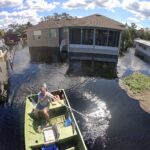Mitigation efforts to reduce property damage, death, injuries and economic loss from the next Hurricane Andrew have been effective where applied, but their use has been spotty and in some cases their benefit diminished by unwise land use policies, according to the Insurance Information Institute (I.I.I.).
Ten years after Hurricane Andrew, many communities still fail to recognize the potential impact of natural disasters in their local land use planning and development practices, making them more vulnerable to damages when natural disasters occur. In addition, many properties are underinsured, uninsured or uninsurable.
Hurricane Andrew, which hit the Bahamas and southern Florida Aug. 23-24, 1992, and then moved across the Gulf of Mexico to strike portions of Louisiana and other southeastern states Aug. 25-26, caused nearly $16 billion in insured damage—$20 billion in today’s dollars—making it the costliest natural disaster in U.S. history. Only the estimated $50 billion in insured losses from the 9/11 terrorist attack is more costly, notes the I.I.I.
With peak wind gusts of almost 200 mph, Hurricane Andrew flattened whole communities, destroying thousands of homes and businesses, battering crops and leaving in its wake a wasteland of debris. Andrew also remains the greatest claims handling challenge the industry has ever faced, producing 700,000 claims in a path of destruction stretching over thousands of square miles.
According to the I.I.I., Hurricane Andrew not only delivered a shocking financial blow to the insurance industry but also to the economy of south Florida, which got the majority of the battering.
“The immediate financial and market consequences of Andrew for insurers were swift, severe and long lasting,” Robert Hartwig, senior vice president and chief economist, I.I.I., said. “Numerous smaller insurers became insolvent and the market for residential and commercial property coverage in coastal areas of the state dried up. Catastrophe reinsurance prices soared and available limits of coverage tumbled. Some Florida subsidiaries of large national insurers required infusions of capital to stay afloat.” Catastrophe modeling firms have estimated that a worst-case scenario event—a Category 5 hurricane striking downtown Miami-could produce insured losses well in excess of $50 billion—one of the largest catastrophe risks anywhere in the United States, the I.I.I. warned. While a $50 billion insured loss would produce a staggering blow to insurers, the total economic loss would likely exceed $80 billion.
According to Hartwig, “efforts to reduce future losses through zoning restrictions or changes in building codes are very valuable, but are often resisted by politically powerful developers and homebuilders as well as real estate interests and proponents of growth. Unless more substantive risk-reduction strategies are adopted-such as building moratoria in those areas that are the most vulnerable to hurricane damage-the benefits from mitigation will remain elusive.”
Was this article valuable?
Here are more articles you may enjoy.


 Death at Universal’s Orlando Resort Roller Coaster Ruled Accidental
Death at Universal’s Orlando Resort Roller Coaster Ruled Accidental  US House Bill Aims to End Private Flood Insurance Coverage Penalty
US House Bill Aims to End Private Flood Insurance Coverage Penalty  Court Awards $32 Million Over Premature Baby’s Death at Yale Hospital
Court Awards $32 Million Over Premature Baby’s Death at Yale Hospital  Fifth La Niña in Six Years to Disrupt Crops and Supply Chains
Fifth La Niña in Six Years to Disrupt Crops and Supply Chains 

